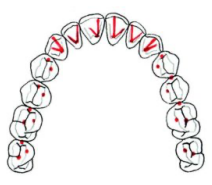Similar to our car tires that function ideally when they are balanced and rotated, our masticatory system (Our Jaw joints (TMJ’s), our masticatory muscles and our teeth) function best when they are working in harmony. Harmony in the masticatory system occurs when there are equal intensity forces on all of your teeth when the jaw joints are in their proper positions. And when functioning, the front teeth separate the back teeth to only engage 1/3 of the masticatory muscles.
When the forces of mastication are in harmony, you should have minimal wear on the jaw joints, the teeth and the muscles of mastication. This harmony ensures longevity of the teeth and surrounding structures. When there is a lack of harmony, over 900 pounds per square inch of pressure can result in the breakdown of some or all of the masticatory structures.
Unstable bites can lead to problems with the teeth, muscles that work the jaw and the jaw joint. Teeth can wear prematurely, fracture and become loose. The jaw muscles can become overworked and sore leading to headaches. In the jaw joint there is cartilage which can become displaced leading to jaw noises, altered jaw movements and pain.
One of the analogies we like to use is if the wheels on your car aren’t balanced, you can still drive the car, but over time the tires will wear out prematurely. Wear and tear to the car can occur, which in the long run is going to cost a lot more than just getting the tires balanced in the first place.

Our goal is to get all the teeth hitting evenly to distribute the bite forces equally to all of the teeth. The simplest way to do that, often times, is to perform an occlusal equilibration. Equilibration on properly selected patients is very predictable, minimally invasive and extremely successful.
An uneven bite is like a four-legged stool that wobbles a little bit.
To fix the wobbly stool, you use a piece of sandpaper, determine which leg
is the longest one, and reduce that leg just enough so that all the legs are even
and the stool is stable on the floor. We do the same thing with the teeth, except
we have more legs to consider.
Once one of the previously listed conditions has been identified, an occlusal analysis is a highly pecialized method of identifying why the problem has occurred and what is the best way to resolve the problem in the most conservative way.
Dr. Thurmon dedicates an appointment entirely to collect all the necessary information needed to
evaluate your bite. This painless appointment takes about an hour and includes a series of photographs
of your teeth, molds or impressions of your teeth, measurements of how your jaws open and close, and a
detailed examination of your joint muscles. After the doctor collects this information, we will study your
bite on a special piece of equipment called an articulator, or bite machine. Our goal is to find the most conservative and least invasive way to protect your teeth and we have found that this method works
very reliably for both the doctor and the patient.
Occlusal Equilibration is a conservative and gentle treatment that reduces the stress on individual teeth or individual parts of the jaw. It creates an even and balanced bite so that normal chewing forces do not put too much stress any one tooth or part of the jaw. It also greatly reduces the amount of stress on the jaw joint or jaw muscles. There are several ways that the doctor’s can create this balance as it is highly personalized to your particular needs.
Dental school is a great foundation for dentists, however, that is just the beginning of their training and knowledge. Top dentists, such as Dr. Thurmon and Dr. Patel at Alpine Creek Dental, spend significant time continuing their professional growth and development every year to be the best dentists they can be. Dr. Thurmon completed an extensive seven series course with Dr. Dawson at the Dawson Academy prior to his passing.
She has had amazing mentors that have helped her understand how the jaw joints are an integral part of the masticatory system. Just as we cannot clap with one hand, we do not chew with one tooth, it is all part of a system. Dr. Thurmon has mentored Dr. Patel and they both are only 10% of Dentists who focus on dental needs not just for the teeth but at the TMJ level to practice more predictable long term dental care.